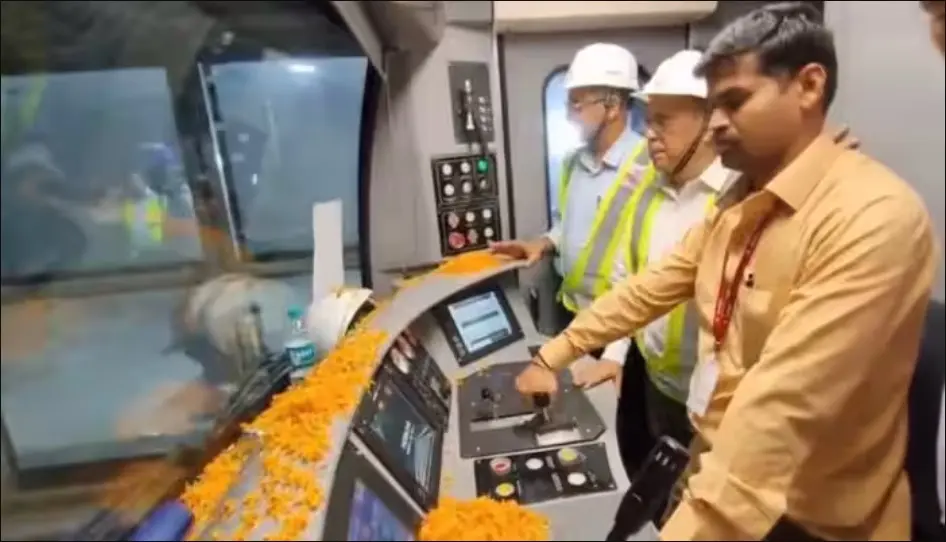Kolkata Metro Makes History by Completing First Under-River Journey in India
In a groundbreaking achievement, the Kolkata Metro has made history by becoming the first metro rail system in India to successfully complete an underwater journey. This remarkable milestone was reached as the metro train passed through an underwater tunnel beneath the Hooghly River, marking a significant leap in India’s urban transportation system. The journey took place with General Manager P. Uday Kumar Reddy aboard rake No. MR-612, as it traveled from the Mahakaran station to the Howrah Maidan station at exactly 11:55 a.m. on the historic day. Accompanying him on this momentous journey were the Additional General Manager and Managing Director of Kolkata Metro Rail Corporation Limited (KMRCL), H.N. Jaiswal, along with other senior metro officials.
The event marked a major achievement not just for Kolkata but for the entire country, as it was the first time that a metro train in India had traveled through an underwater tunnel. This technological feat had been in the making for several years as part of Kolkata Metro’s East-West Corridor project, which has been widely recognized for its complexity and the challenges posed by the Hooghly River. The tunnel, constructed using advanced engineering techniques, connects the city’s bustling urban landscape with its surrounding suburbs, providing a more efficient and modern mode of transportation for the millions who depend on the Kolkata Metro.
Symbolic Journey Across the Hooghly
The symbolic significance of the journey was not lost on the officials and citizens alike. The Hooghly River has historically been an essential lifeline for Kolkata, serving as a major route for trade and communication since colonial times. Now, with the completion of the underwater metro tunnel, the river becomes part of a new chapter in Kolkata’s ongoing modernization efforts, linking its rich past with a future focused on cutting-edge infrastructure.
As the train made its way beneath the river, it passed through the twin-tunnel system, which is located about 33 meters below the riverbed. The journey itself took a matter of minutes, but its impact will be felt for years to come. The project is a significant part of the city’s overall plan to ease traffic congestion and provide a more efficient and environmentally friendly transportation option for its rapidly growing population.
Ceremony and Celebrations at Howrah Maidan Station
Upon arriving at Howrah Maidan station, the importance of the occasion was further underscored with a traditional ceremony. General Manager Reddy, along with other senior officials, performed a puja to seek blessings for the successful operation of the metro and to mark the auspicious moment. Following the ritual, rake No. MR-613 was also brought to Howrah Maidan station, signaling the operational readiness of multiple metro trains for this route.
The celebrations didn’t stop there. The arrival of the metro was greeted with great fanfare, with flowers being showered on the train and coconuts ceremonially smashed to commemorate the achievement. It was an emotional moment for the team of engineers, workers, and officials who had spent years overcoming challenges to bring this project to fruition. The event was also attended by local dignitaries, residents, and media, all of whom were eager to witness this milestone in the city’s history.
Years in the Making: The Challenges of the East-West Corridor Project
The underwater metro journey was not only a technological achievement but also the culmination of years of planning, hard work, and perseverance. The East-West Corridor project, of which the underwater tunnel is a key part, has faced numerous challenges since its inception. The construction of the tunnel required highly specialized engineering techniques, given the unstable nature of the riverbed and the complexities of building under an active waterway. Advanced Tunnel Boring Machines (TBMs) were deployed to carve out the path for the metro lines, making sure the structure was sturdy enough to withstand the immense pressure from the river above.
Delays due to logistical, technical, and environmental hurdles pushed the completion date back several times. The tunnel’s construction also required coordination with multiple government agencies and private contractors, who all worked together to ensure the safety and efficiency of the project. This success is a testament to the hard work and expertise of all those involved in the process.
Future of Transportation in Kolkata
With the successful completion of this historic underwater metro journey, Kolkata is now poised to further expand its metro network. The East-West Corridor will provide a crucial link between the bustling IT hubs and commercial centers in the east, and the historically significant districts in the west, including Howrah. The metro will not only reduce travel time for commuters but also help decongest the city’s notoriously crowded roads. It is expected that the new line will drastically reduce travel time between Howrah and Salt Lake, making it one of the most important metro routes in the city.
The underwater metro service is expected to cater to thousands of daily commuters, offering a seamless and modern alternative to the ferry services that currently operate across the Hooghly River. The expansion of the metro will also help reduce the carbon footprint of the city, providing a cleaner, more sustainable transportation option.
India’s First Underwater Metro: A Game-Changer
The Kolkata Metro’s successful underwater journey marks a significant milestone not just for the city but for India as a whole. It places India among a select group of countries that have developed and successfully operated underwater metro systems, showcasing the nation’s growing capabilities in urban infrastructure and engineering. The tunnel is now a symbol of India’s engineering prowess and a sign of what is possible with the right vision, resources, and determination.
For the people of Kolkata, the underwater metro is more than just a mode of transportation—it is a point of pride. The city has always been known for its cultural heritage, intellectual legacy, and resilience. With this historic achievement, Kolkata now adds another feather to its cap, cementing its place as a leader in technological and infrastructural innovation in India.
